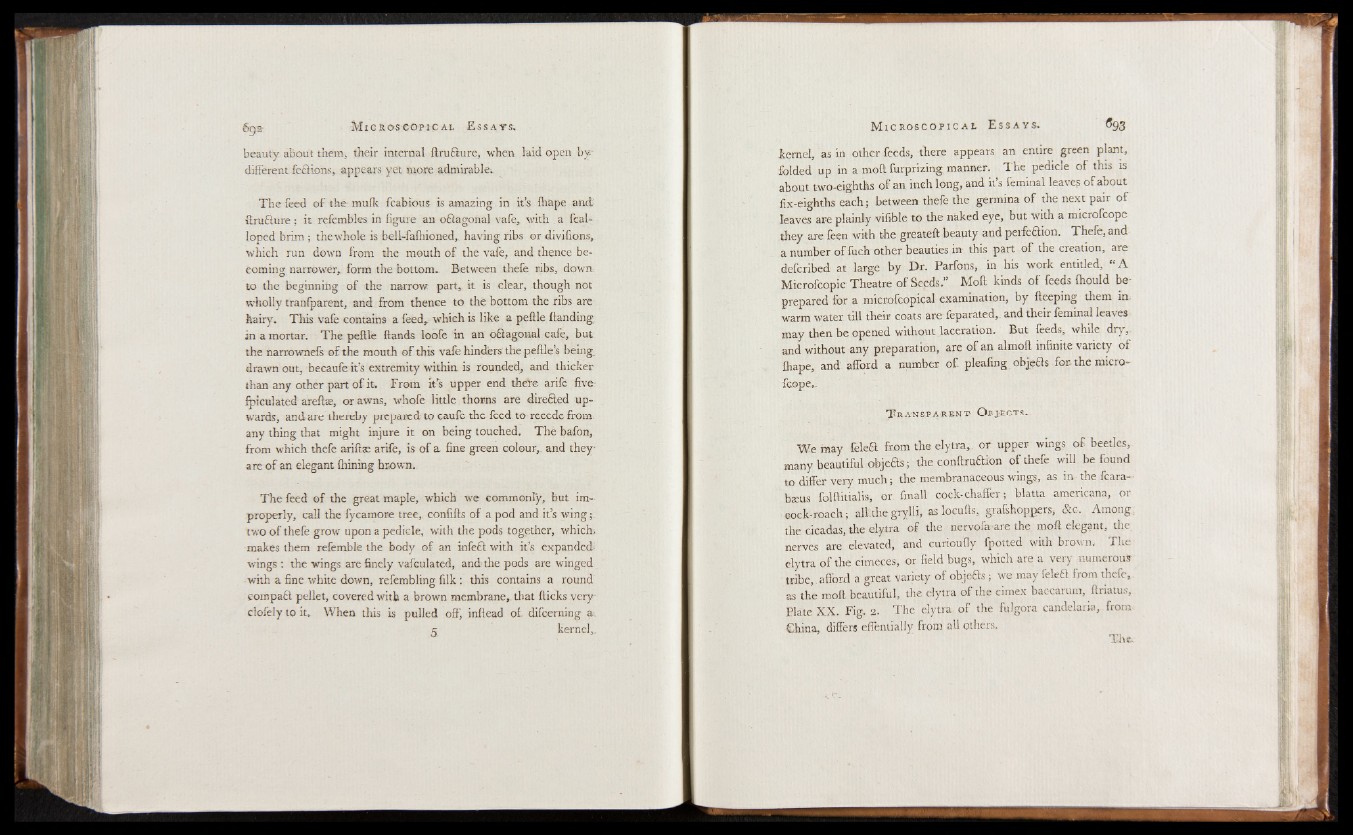
beauty about them, their internal flrufture, when laid open b y
different feci ions, appears yet more admirable;
The feed of the mulk fcabious is amazing in it’s lhape and:
3ru6lure ; it refembles in figure an oftagohal vafe, with a fcal-
loped brim ; thewhole is bell-falhioned, having ribs or divifions,
which run down from the mouth of the vafe, and thence becoming
narrower, form the bottom. Between thefe ribs, down
to the beginning o f the narrow part, it is clear, though not
wholly tranfparent, and from thence to the bottom the ribs are
hairy. This vale contains a feed, which is like a peftle Handing
in a mortar. The peftle Hands loofe in an oftagonal cafe, but:
the narrownefs of the mouth of this vafe hinders the peftle's being,
drawn out, becaufe it’s extremity within is rounded, and thicker
than any other part o f it. From it’s upper end there arife five
fpiculated areftse, or awns, whofe little thorns are direfied upwards,
and are thereby prepared to caufe the feed to recede from,
any thing that might injure it on being touched. The bafon,
from which thefe ariftse arife, is of a fine green colour, and they
are o f an elegant Alining brown.
The feed o f the great maple, which we commonly, but improperly,
call the fycamore tree, confifts of a pod and it’s wing
two of thefe grow upon a pedicle, with the pods together, which;
makes them refemble the body of an infeft with it’s expanded;
wings : the wings are finely vafculated, and the pods are winged
with a fine white down, refembling filk : this contains a round
gompaft pellet, covered with a brown membrane, that flicks very
clofely to it. When this is pulled off’, inftead of. difcerning a.
g kernel,
kernel, as in other feeds, there appears an entire green plant,
folded up in a moft furprizing manner. The pedicle of this is
about two-eighths o f an inch long, and it’s feminal leaves o f about
fix-eighths each; between thefe the germina o f the next pair of
leaves are plainly vifible to the naked eye, but with a microfcope
they are feen with the greateft beauty and peifeftion. Thefe, and
a number o f fuch other beauties in this part of the creation, are
defcribed at large by Dr. Parfons, in his work entitled, “ A
Microfcopie Theatre o f Seeds.” Moft kinds o f feeds Ihould be-
prepared for a microfcopical examination, by fteeping them in.
warm water till their coats are feparated, and their feminal leaves
may then be opened without laceration. But feeds, while dry,,
and without any preparation, are o f an almoft infinite variety of
lhape, and afford a number of. pleafing objefls for the micro-
fcope.
T ransparent. Objects,
We may feleS from the elytra, or upper wings of beetles,
many beautiful objeas; the conftruaion of thefe will be found
to differ very much; the membranaceous wings, as in thefcara-
baius folftitialis, or final! cock-chaffer; blatta americana, or
cock-roach; alKthe grylli, as locufts, grafshoppers, &c. Among;
the cicadas, the elytra of the nervofa are the moft elegant, the
nerves are elevated, and curioufly fpotted with brown. The
elytra of the cimeces, or field bugs, which are a very numerous
tribe, afford a great variety of objeas; we may feleft from thefe,
as the moft beautiful, the elytra of the cimex baccarum, ftriatus,
Plate XX. Fig. 2. The elytra of the fulgora Candelaria, from
China, differs effentially from all others.
The.